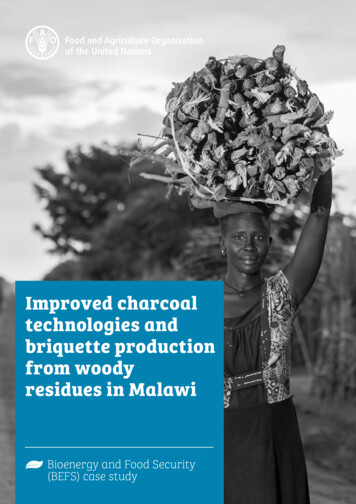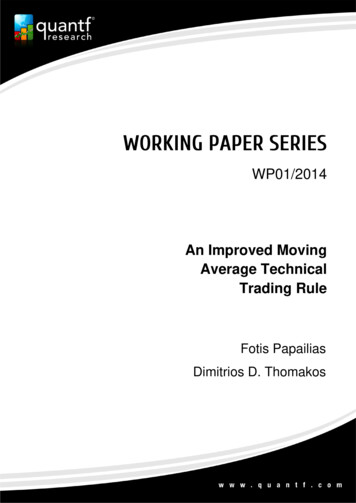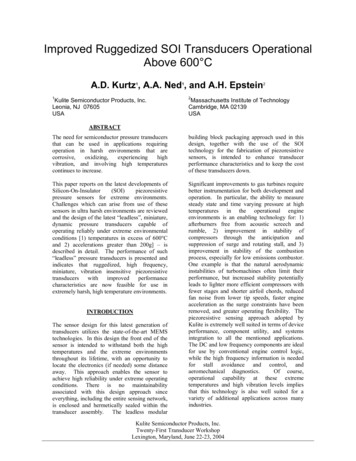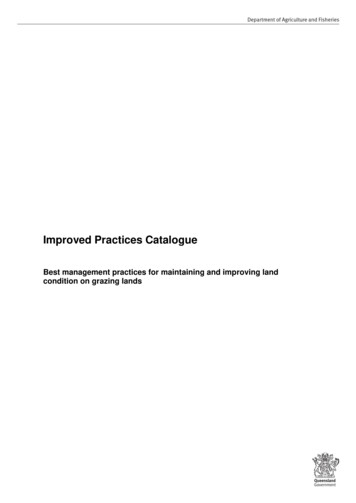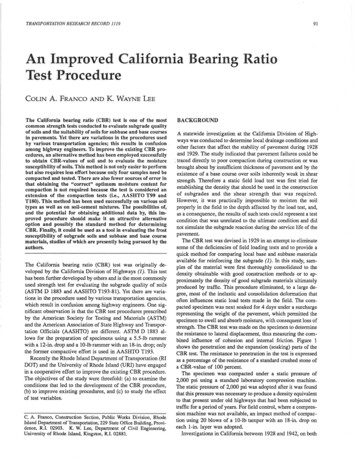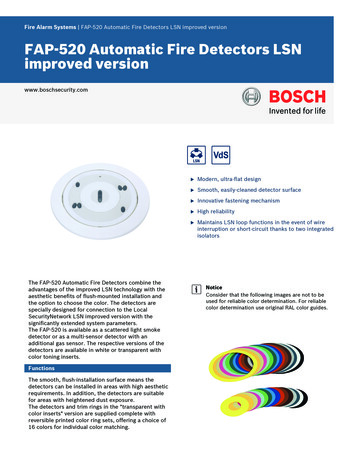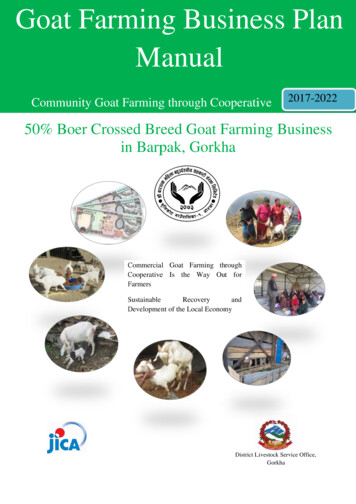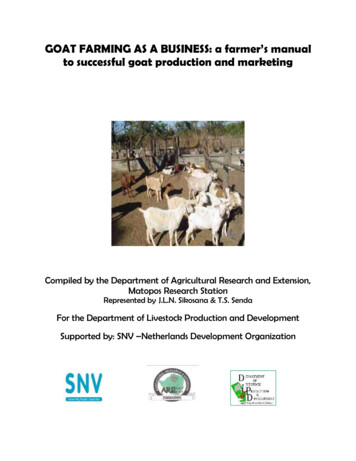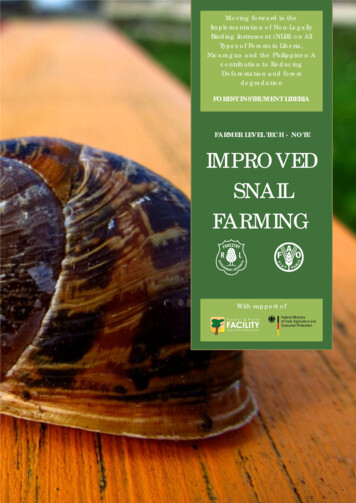
Transcription
Moving forward in theImplementation of Non-LegallyBinding Instrument (NLBI) on AllTypes of Forests in Liberia,Nicaragua and the Philippines: Acontribution to ReducingDeforestation and forestdegradationFOREST INSTRUMENT LIBERIAFARMER LEVEL TECH - NOTEIMPROVEDSNAILFARMINGWith support of
The views expressed in this information product are those of the author(s) and do notnecessarily reflect the views of BMELV, FAO, FDA, NFP Facility.April 2013ii
AcknowledgementThis tech note has been developed by Mr. Ezekiel Tyre Freeman. Several peopleparticipated in the preparation of this document and delivery of the training of trainers. Ms.Charlotte Lietaer, FAO Rome made valuable contributions to improve the content of thedocument. Mr. Sormongar S. Zwuen, , National NLBI project coordinator, Mr. Joseph Boiwu,FAO Representative Operations Assistant and Dr. Jhony Zapata, FAO/FFF Rome providedoverall guidance. Mr. Edward Kamara, Manager Forest Products Marketing and RevenueForecast, FD, Mr. Edward Suloe, CFDC Facilitator made contributions for the piloting of thisdocument and Marco Perri FAO/FFF for the layout and formatting.Sincerest gratitude goes to Ms. Eva Muller Director, Forest Economics, Policy and ProductsDivision, FAO for her leadership and strategic guidance. Special recognition goes to theFederal Ministry of Food, Agriculture and Consumer Protection (BMELV) of Germany for thefinancial support provided.iii
PrefaceIn May 2007, the National Forum on Forests (UNFF) adopted the Non-Legally BindingInstrument on All Types of Forest (NLBI), which is commonly called the “Forest Instrument”.This significant international consensus was reached to boost the implementation ofsustainable forest management (SFM), and thus to maintain and enhance the economicand environmental values of all types of forests, for the benefit of present and futuregeneration. Most specifically, the Forest Instrument is to: (i) Strengthen politicalcommitment and actions at all levels to effectively implement SFM, (ii) Enhance thecontribution of forests to the achievement of the international agreed development goalsincluding the MDG, and (iii) Provide a framework for national action and internationalcooperation.The overall objective of the project is “to support Liberia, Nicaragua and the Philippines,on a demonstration basis, to move forward in the implementation of the Non-LegallyBinding Instrument on all types of forest”.Towards this end, an agro forestry component under the Project is providing intensivetraining to rural communities in three Counties, including Nimba, Grand Gedeh , and RiverGee respectively in the areas of beekeeping and snail farming and total of 60 farmerswere trained.There isn’t any real history on were snails eating started from or when people startedeating snail. In Liberia, edible snails can be found in the forest, in the swamp and ongarbage sites. People gather snails, eat them and sell the remaining as a way to makemoney. This Farmers level Tech-Note aims to provide inspiration to farmers who would liketo produce snails on a small scale for eating or selling. It is not for farmers who want sell orexport snails in large-scale. The tech-note is focused on the three types of edible snailsthat are common in Liberia, the forest snail or giant African snail (Achatina achatina), theswamp snail (Archachatina marginata), the city girl (Achatina fulica).Through this publication, FAO and FDA, Forest Development authority of Liberia (FDA)want to contribute to the income generation and food security of the Liberian farmers.Jean-Alexandre ScagliaHarrison S. Karnwea,FAO Representative in LiberiaManaging Director a.i., FDAiv
Table of ContentsAcknowledgement . iiPreface . iv1. Introduction . 12. Advantages and disadvantages of snails farming . 22.1 Advantages of snails farming . 22.2 Disadvantages of snails farming . 23. Suitable tropical snail species for farming . 34. Choosing a site . 45. Soil characteristics. 46. Constructing a snailery . 57. Choosing a system: the options . 68. Types of snail food. 119. Breeding and management . 139.1 Selecting breeding stock . 139.2 Nursery . 149.3 Rearing density . 159.4 Seasonal and daily management . 159.5 Snail farming tools and equipment . 1610. Predators, parasites and diseases . 1711. Processing and consumption of snail meat. 1911.1 Processing of snail meat . 1911.2 Consumption of snail meat . 20v
vi
1 IntroductionWe do not have any real history were snails eating started from or when people startedeating snail. In Liberia, edible snails can be found in the forest, in the swamp and ongarbage sites. People gather snails, eat them and sell the remaining as a way to makemoney. This Farmers level Tech-Note aims to provide ideas to farmers who would like toproduce snails on a small scale for eating or selling. It is not for farmers who want sell orexport snails in large-scale.The tech-note is focused on the three types of edible snails that are common in Liberia:The forest snail/Giant African snail (Achatina achatina)The swamp snail (Archachatina marginata)The city girl (Achatina fulica)1
2. Advantages and disadvantages of snailsfarming2.1 Advantages of snails farmingEnvironmentSnails are environment-friendly, because, unlike poultry or pigs, neither the snail nor itsdroppings smell offensively. Snails can also be reared in the backyard. Also, snails manureimprove the organic content of the soil.InputCapital, technical, labor and financial inputs in simple snail farming are relatively lowcompared to those in other types of livestock farming (poultry, pigs, goats, sheep, cattle).Snail meatSnail meat is a good source of protein. It is rich in iron and calcium, but low in fat andcholesterol compared to other protein sources like poultry and pigs.2.2 Disadvantages of snails farmingClimateWithout expensive artificial means of climate control, snail farming is restricted to thehumid tropical forest zone, which offers a constant temperature, high relative humidity,preferably no dry season, and a fairly constant day/night rhythm throughout the year.Cultural limitsSnail meat is considered a delicacy by some, whereas others will not even touch it forreligious or cultural reasons.GrowthSnails are relatively slow-growing animals. Furthermore the consumable meat makes uponly 40% (maximum!) of the snail's total live weight. Consequently snail farming is not away to make money quickly!Snails as a pestSnails that have escaped from a farm, or been dumped by a farmer, may quicklydevelop into a serious pest in agriculture.For these reasons it must be emphasized that snail farming should be seen as only onecomponent in a diversified farming venture. But there are many examples of cases inwhich giant African land snails (GALS) were introduced to other parts of the world forfarming, but were eventually dumped (or allowed to escape) into the wild for lack of amarket. Once the snails have been introduced, dumped or allowed to escape, theydevelop into agricultural pests. Without any natural elements, they end up destroying awide range of agricultural crop and causing considerable economic damage. Achatinafulica (city girl in local language) has a particularly poor reputation in this respect. Thegiant African snails/forest snails are considered a delicacy by people accustomed to2
consuming them, whereas other people, even within the same country, will not eventouch, let alone eat them. For that reason, don't start farming snails unless you areabsolutely sure someone will buy or eat them.3.Suitable tropical snail species for farmingScientific nameLocal names/LiberiaOther names usedAchatina achatinaForest snailGiant African snail, Tiger snailArchachatina marginataSwamp snailBig black snail, Giant Africanland snailAchatina fulicaCity girlGarden snail, Foolish snailForest snailSwamp snailCity girl3
4. Choosing a siteSnails are good at escaping from enclosures. A priority in setting up a productive snailfarming venture, therefore, is to construct escape proof housing. There are several typesof snail housing (snaileries) to choose from, depending on the size of the venture. The firststep, however, is to select an appropriate site. The main factors to consider in siteselection are the following: (Micro)climateWind speed and directionSoil characteristicsSafety(protecting the snails from diseases, predators and poachers)5. Soil characteristicsSoil is a major part of a snail's habitat. Soil composition, water content and texture areimportant factors to consider in site selection.The snail's shell is made up mainly of calcium derived from the soil and from feed.Snails derive most of their water requirements from the soil. Snails dig in the soil to lay theireggs and to rest during the dry season.Soils with high organic matter support the growth and development of snails. In general,if a soil supports good growth of cocoyam, tomatoes and leafy vegetables, it is suitablefor snail farming. Before introducing snails to the site, the soil should be loosened by tilling.Snails need damp, not wet, environments. Although snails need moisture, you must drainwet or waterlogged soil.Calcium and magnesium stimulate growth best. Calcium may also be set out in a feedingdish or trough so the snails can eat it at will.Snails dig in soil and ingest it. Good soil favors snail growth and provides some of theirnutrition.Lack of access to good soil may result in fragile shells even if the snails have wellbalanced feed; the snails’ growth may lag far behind the growth of other snails on goodsoil. Snails often eat feed, then eat dirt. Sometimes, they eat only one or the other.Eventually the soil in the snail pens will become fouled with mucus and droppings.Chemical changes may also occur. The soil must, therefore, be changed once everythree months.4
6. Constructing a snaileryThe type and dimensions of your snailery or snaileries depend, obviously, on the snailgrowing system you choose, and on the quantity of snails you intend to produce. As far ashousing is concerned, your snail farm could be extensive, semi-intensive, or intensive, inincreasing order of complexity, management and financial inputs.Three options might be considered:1.2.3.Extensive system: outdoor, free-range snail pens.Mixed, or semi-intensive system: egg laying and hatching occur in a controlledenvironment; the young snails are then removed after 6-8 weeks to outside pens forgrowing or fattening or both.Intensive system: closed systems, for example plastic tunnel houses, greenhouses andbuildings with controlled climate. (Note: the same options of extensive, semi-intensive,or intensive apply to feed and feeding).Regardless of the size and type of your snail farm, the housing system must meet thefollowing conditions.It must be:1.2.3.4.escape-proof: snails are master-escapists and unless prevented from doing so theywill quickly wander all over your (or your neighbors’) garden or house;spacious, in accordance with the growing stage of the snails (hatchlings, juveniles,breeding snails, or mature snails fattened for consumption). Snails suffer fromovercrowding, which impedes their development and increases the risk of diseases.Suitable rearing densities range from 100/m2 for hatchlings to 7-10/m2 for breedingsnails;easily accessible and easy to work in or with, for handling the snails, placing feed,cleaning and other tasks;well-protected from insects, predators and poachers. Different materials can be usedfor building snailearies , depending on price and availability.The materials you will need are:1.2.3.4.5.Decay- and termite-resistant timber, cement blocks, or mud bricks.Galvanized sheets or polythene sheets.Chicken wire, for protection.Mosquito nets or nylon mesh, for covering the pens as protection against insects.Second-hand materials, like car tires, oil drums and old water tanks.5
7. Choosing a system: the optionsIn addition to car tires, oil drums and such materials, the following types of pens might beconsidered for simple snaileries: Hutch boxes/cagesTrench pensMini-paddock pensFree-range pensCar tires, oil drumsDiscarded tires or oil drums may serve as relatively cheap snail pens. Three or four tires areplaced on top of each other, with chicken wire and mosquito mesh between the topmosttire and the second one from the top.Oil drums should have some holes in the bottom for drainage, be filled with good soil to adepth of 7-10 cm, and be fitted with wire plus mosquito mesh on top. Such pens aresuitable for keeping a few snails (up to about four mature snails in each container) closeto the house, for private use.Hutch boxesDescriptionHutch boxes are square or rectangular, single or multi-chamber wooden boxes with lids,placed on wooden stilts above the ground at a suitable height for easy handling. The stiltsshould be fitted with plastic or metal conical protectors or aprons, to prevent vermin fromcrawling or climbing up the stilts to attack the snails in the boxes. The protectors could bemade from old tins or plastic bottles. In the middle of the lid is an opening covered withwire netting and nylon mesh. The lid should be fitted with a padlock to discouragepilfering. In the floor of the box are a few holes through which excess water can drain out.The boxes are filled with sieved black soil to a depth of 18-25 cm. The box(es) shouldobviously be well protected from scorching sun or torrential rain.Drawing 1: Hutch box with single (left) and double (richt) chamberHutch boxes are useful in a semi-intensive snail breeding system. They are very suitable ashatchery and nursery pens because eggs and young snails can be easily located andobserved.6
Trench pensDescriptionTrench pens are adjoining snail pens of 0.6 0.6 m to 1 1 m, either dug into the ground(which must be very well-drained), or raised 40-50 cm above the ground. Outside wallsand inner partitions consist of sandcrete blocks or mud bricks in either case. The pens arefilled with suitable soil to a depth of 10-15 cm. They are covered with wooden or steelframe lids with chicken wire plus nylon mesh, and fitted with padlocks to discouragepoachers. Obviously the pens must be protected against the fierce heat of the sun orheavy rain. Shredded semi-dry banana leaves may be spread in the pens to provideshelter for the snails.Drawing 2: Two types of trench pens. A: dug in trench pen, B: raised trench penTrench pens are suitable in semi-intensive to intensive snail growing ventures. They can beused as hatchery, nursery or fattening pens, with the number of stock being adapted tothe size of the snails in each case. The snails can be moved from one pen to anotheraccording to the growing cycle.Advantages and disadvantagesThe main advantage of a trench pen system, whether sunken or raised above theground, is its flexibility. Snails can be moved around easily,in accordance with their size and phase in the growing cycle. The snails are always easyto locate, for feeding, handling, and selection for final sale and consumption.7
Mini-paddock pensDescriptionMini-paddock pens are small square or rectangular pens, usually within a larger fencedarea. They are built of bamboo and nylon mesh, or of timber, chicken wire and nylonmesh.Drawing 3: Mini-paddock pen built with bamboo and nylon meshThe walls should be some 50 cm high and be dug at least 20 cm into the ground. Woodenframes are attached to the top of the walls (extended inwards) and covered with themesh, to prevent snails from escaping as shown in drawing 3.Plants providing shelter and/or food are planted in the pens before snails are releasedinto them. Suitable plants include cocoyam, sweet potato, fluted pumpkin, and leafyvegetables. Rectangular pens allow the farmer easier access to the whole area withouthaving to enter the pens. Mini-paddock pens may also be constructed higher aboveground, with a completely enclosed frame, and may even be roofed. Application anduse mini-paddock pens, like free-range pens are suitable as fattening pens, where snailsthat are no longer needed for breeding are allowed to put on weight before beingcollected for consumption or sale. Additional snail food may be placed in the pen, butuneaten food must be removed regularly. Food and shelter plants must be replanted fromtime to time.Advantages and disadvantagesThe advantage of mini-paddock pens is that snails grow in an environment resemblingtheir natural habitat without much additional effort from the farmer. The limiteddimensions of the pen still permits close supervision. The main disadvantage would seemto be that the snails are not protected against predators, unless the pen is entirely closedand roofed, which makes it more expensive.8
Free-range pensDescriptionEssentially, free-range pens are large mini-paddock pens: a fenced area of up to 10 20m, planted with plants, shrubs and trees that provide food and shelter from wind, sun andrain. Just like in a mini-paddock pen, the vertical fence must be extended inwards, toprevent snails from escaping. If the fence is constructed of fine chicken wire mesh, theoverhang is not obligatory because snails dislike crawling on wire mesh.The fence must be dug at least 20 cm into the ground. The free-range pen might even becompletely enclosed and roofed.Drawing 4: Open free-range snail pen with vegetation providing shelter for the snails.Application and useFree-range pens may serve as the sole snail enclosure in cycle of the snail develops withinthe open pen an extensive snail farming system, or as growing and fattening pens in asemi intensive one. In the extensive snail farm the entire life cycle of the snail developswithin the open pen: mating, egg laying, hatching, hatchling development, and growthof the snails to maturity. Snails feed on the plants provided in the pen. In a semi-intensivesnail farm the free-range pen serves as a growing and fattening pen for adult snails,which were raised through the egg hatchling- juvenile stages in hutch boxes or trenchpens.Advantages and DisadvantagesIn an extensive system using a free-range pen the snails develop in a near-normal habitat.They will take shelter in the vegetation or the soil during the day, coming out at night tofeed. A simple fenced free-range pen is relatively simple and cheap to construct.Management is restricted to occasional replanting of food and shelter plants. If thevegetation within the pen is kept in shape, additional feeding of the snails is notnecessary. A fully enclosed and roofed pen is quite costly to build, obviously, especially ifprovided with a concrete apron and drain.9
Drawing 5: Fully enclosed and roofed free-range pen with concrete apron and drain.Both types require the availability of land with a secure title, considering the investmentinvolved, specifically for the fully enclosed and roofed variety.The free-range pen has several disadvantages. It requires more land than other types ofsnail farming. It is difficult to locate and protect eggs and small snails. This may lead topoor disease management and higher mortality compared to other snail productionsystems. It is difficult to keep track of snail performance and, for that reason, to keepuseful records of inputs and output. In the open type of free-range pen it is more difficultto keep out predators and poachers. Besides the natural shelter provided in minipaddock and free-range pens, it is advisable to also provide other forms of shelter toensure that the snails are not exposed to too much heat. For example, concave tiles orsplit bamboo can be placed on stones on the ground, with the concave side facingdownwards. On very hot days, the soil can be cooled by sprinkling water on it.10
8. Types of snail foodWhat snails eatSnails are vegetarian and will accept many types of food. All snails will avoid plants thathave hairy leaves or produce toxic chemicals, like physic nut (Jathropa curcas). Youngsnails prefer tender leaves and shoots; they consume about twice as much feed asmature snails. As they get older, mature snails increasingly feed on detritus: fallen leaves,rotten fruit and humus should be introduced gradually.What snails needSnails need carbohydrates for energy, and protein for growth. In addition they requirecalcium (Ca) for their shells, as well as other minerals and vitamins. Snail meat is low incrude fiber and fat; for that reason, these components are of minor importance in snailfeed.Recommended food itemsLeaves: cocoyam, kola, paw paw, cassava, okra, eggplant, loofa, centrosema, cabbageand lettuce. Paw paw leaves (as well as its fruit and fruit peels) stand out in many trials asgood snail food.Fruits: paw paw, mango, banana, eggplant, pear, oil palm, fig, tomato and cucumber.Fruits are usually rich in minerals and vitamins, but low in protein.Tubers: cocoyam, cassava, yam, sweet potato and plantain. Tubers are a good source ofcarbohydrates, though low in protein.Household waste: peels of fruit and tuber, like banana, plantain, pineapple, yamespecially paw paw, and leftovers like cooked rice, beans, fufu and eko. Caution:household waste must not contain salt!Recommendations on natural feedMarket waste: because snails are vegetarians, the cheapest way to feed them is bycollecting rejected food from marketplaces. At the end of any market day, someperishable vegetables and fruits still useful for snail consumption can be collected fromthe dumping areas. This would reduce the cost and labour of buying or cultivatingvegetables and fruits only to feed snails. Caution: you should not collect vegetables andfruits that are decaying.Snails can feed on a large range of food items but feed containing waxy or hairy leavesshould be avoided. Providing the forest snail with a mixture of foods, rather than only one ortwo items, will enhance its growth. Food attractiveness is important in the nutrition of thisspecies. If the food is appetizing (e.g. paw paw) the snails will eat a lot and grow quickly. Iffood is unattractive, however nutritious it may be, the snails will not eat much of it.Paw paw leaves, fruit and peels are a good source of crude protein. For strong growthand good shell development, powdered calcium sources from egg shells, limestone,wood-ash, oyster shells (crushed), or bone meal, should be added to the feed at a levelof about 15 to 20% of diet dry matter. Crushed oyster shell calcium is best.Snails need water! Most is supplied by the food they consume, but additional water mustbe supplied in the growing pens: a water soaked sponge or a dot of cotton wool for11
hatchlings and juveniles, in shallow dishes (otherwise the snails may drown) for matureand breeding snails.Supplementary vitamins. Other food plants known to contain moderate amounts ofvitamins D, E and K should be added. Examples are sunflower and copra cake (vitaminD), wheat germ, lettuce and other vegetables (vitamin E), cabbage and African spinach(vitamin K).Supplementary calcium. If the soil is not high in calcium, supplementary calcium will beneeded. This can be provided by sprinkling powdered oyster or snail shells or groundlimestone onto leafy vegetables.Supplementary minerals. Other minerals can be provided by placing licking stonescontaining the mineral in the pen.12
9. Breeding and managementAlthough snails are hermaphrodites (i.e. they have male and female parts), in mostspecies the individuals mate with each other before laying eggs.In extensive snail farming in free-range pens, the snails follow their natural life cycle.Interference from the snail farmer is restricted to the daily removal of any dead snails,refilling watering troughs, keeping the soil moist in the dry season, and occasionallyharvesting mature snails for sale or for the cooking pot.In semi-intensive or intensive snail farming the farmer will actively manage the snailsduring the successive stages of their life cycle: egg laying, hatching, growing andmaturity. Management activities proceed in tune with the snails' life cycle, which in turnfollows the seasons with their periods of snail activity and of dormancy (aestivation duringthe dry seasons). (Note: Domesticated snails continue to lay eggs in the rainy and dryseasons).9.1 Selecting breeding stockIt is recommended to use sexually mature snails, weighing at least 100-125 g, as initialbreeding stock. Farming should preferably start at the onset of the wet season, becausethat is the time snails normally start to breed. Until snail farms become self-sustaining,farmers may have to collect snails from the wild or buy them cheaply in the peak seasonand fatten them in captivity in the off season. In relatively undisturbed forest areas, snailscan be collected on days following rains. Snails are active at night and on cloudy orfoggy mornings. During the day they tend to keep well hidden, so it is best to collect themat night or early in the morning, when the sun is low and the humidity high. Farmerspurchasing breeding stock from snail gatherers or from the market should expect a fairlyhigh level of mortality as a result of poor handling and the adjustment to different foods.The most reliable way of obtaining parental stock is from known breeders, or fromagricultural institutes. Such parent snails might be more expensive than snails from othersources, but they are better and safer because they have been properly fed andmanaged from hatching, and have not been damaged during collection andsubsequent handling. Once the snail farm is established, farmers should select breedingstock from their own snails. Breeding stock must be selected in the wet season precedingaestivation, based on the following attributes:Fecundity (expected number of eggs, based on numbers laid in previous seasons)Hatchability (percentage of eggs likely to hatch out of the total number laid) .Establishment rate (percentage of snails likely to survive after hatching)Growth rateShell strengthSimple records kept by snail farmers can provide the necessary information. As a generalrule, the fastest growers with the strongest shells should be selected as breeding stock. Thestronger its shell, the better the snail is protected against predators.13
9.2 NurserySnails selected as breeding stock are placed in hutch boxes or trench pens, which mustcontain feed and water troughs. Some farmers let snails lay eggs in the grower pens, andthen transfer the eggs to the nursery boxes or pens, but this is not recommended. It maybe difficult to locate the eggs, and the eggs may be physically damaged during thetransfer. A breeding snail may lay one to three egg masses (clutches) per season. Thenumber of breeding snails placed in a hutch box/ snail cage depends on the fertility ofthe group and on the number of young snails required. The latter depends on the penspace available. After egg laying, the parent snails should be returned to their growerpens. In forest snails, large differences have been observed in egg production within andbetween populations. Generally, snails lay between 100 and 400 eggs. The eggs arebroadly oval and measure about 5 mm long. They are usually laid in round-shaped holesdug 2-5 cm deep in the soil. Occasionally they are laid on the soil surface or at the baseof plants. Snail eggs require a certain amount of warmth to induce hatching.They usually hatch 12-20 days after laying.Drawing 6: egg laid in a hole dug in the soilIn forest snails, the baby snails have light-brown shells with black stripes. They should bekept in the boxes and fed on vegetable or fruit leaves (like cocoyam and paw pawleaves), fruits (preferably paw paw), powdered oyster shells and water until they are bigenough to move to grower pens. Young snails do best if they are kept with snails of thesame size.The eggs of the city girl are small (4 mm) and are laid in clutches of 10 to 400; usually aparent snail lays several clutches in a year. Hatchlings remain 5-15 days undergroundbefore emerging.The eggs of swamp snai
People gather snails, eat them and sell the remaining as a way to make money. This Farmers level TechNote aims to provide inspiration to farmers who would like - to produce snails on a small scale for eating or selling. It is not for farmers who want sell or export snails in large-scale. The
